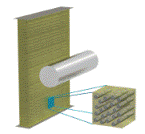Mechanical and Materials Engineering, Department of

Department of Engineering Mechanics: Dissertations, Theses, and Student Research
Date of this Version
Fall 12-2-2011
Document Type
Thesis
Abstract
Recent advances in patterning techniques and emerging surface microtechnologies have allowed cell micropatterning to control spatial location of the cells on a surface as well as cell shape, attachment area, and number of contacting neighbor cells. These parameters play important roles in cell cellular behaviors. Cell micropatterning has thus become one of the most important strategies for biomedical applications, such as, tissue engineering, diagnostic immunoassays, lab-on-chip devices, bio-sensing, etc., and cell biology studies as well. For neuronal cells, there have been attempts to distribute neuronal cells on specific patterns to control cell-to-cell interaction. However, there have been very limited understanding on the effects of micropattern size and specific ECM proteins used for patterning on neuronal cell behavior. In this work, in-vitro neuronal cell patterning was performed using various ECM protein lane widths with or without neuronal biochemical factor to investigate neuronal cell response to controlled microenvironments.
We have developed a technique to organize cells into pre-assigned boundaries while maintaining their original properties of growth, proliferation, and differentiation. Soft lithography and microcontact printing were used to pattern arrays of Collagen-I ECM lanes with 5, 10, 20, 30, and 40 µm width separated by 50 µm gap. PLL-g-PEG was flooded before culturing SH-SY5Y cells. Cells did not prefer small adhesive lanes, but attached on as small as 5µm ECM lanes if cell-repellent backfilling was utilized. On 5 and 10 µm lanes, cell and nuclear growth was constrained as compared to unpatterned control, and wider lanes. Cells showed near perfect orientation along the adhesive lanes for 5 and 10 µm width lanes. With increasing lane width, neuronal cell orientation was influenced adversely, e.g., increased deviation from the patterning direction. When stimulated by retinoic acid (RA), cells patterned on 5 and 10 µm lanes showed well-developed, long neurites along the protein pattern connecting neighboring cells. The neurite length was shorter on wider lanes. Our data may provide a new insight for neuronal tissue engineering on how to regenerate damaged neurons using more controlled physical-biochemical environments.
Adviser: Jung Yul Lim
Included in
Bioelectrical and Neuroengineering Commons, Biological Engineering Commons, Biomaterials Commons, Biomechanical Engineering Commons, Biomedical Devices and Instrumentation Commons, Molecular, Cellular, and Tissue Engineering Commons, Nanoscience and Nanotechnology Commons, Polymer and Organic Materials Commons


Comments
A thesis Presented to the Faculty of The Graduate College at the University of Nebraska In Partial Fulfillment of Requirements For the Degree of Master of Science, Major: Engineering Mechanics, Under the Supervision of Professor Jung Yul Lim. Lincoln, Nebraska: November, 2011
Copyright (c) 2011 Ishwari Poudel